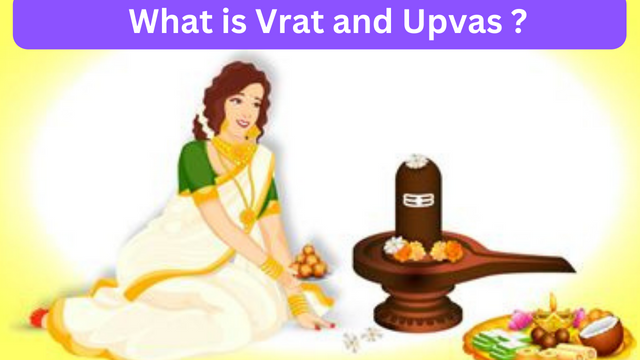Vrat and Upvas has an important place in almost all countries and religions of the world. According to the scholars of Hindu culture, fasting is also called Sankalpa, Satkarma rituals. By fasting, the conscience of a man becomes pure. This increases knowledge power, thinking power, intelligence, devotion, intelligence, devotion and purity, a single fast / fast destroys many physical diseases. Regular fasting and observance of fasts lead to good health and longevity – this is undeniable. It has been said in the scriptures, ‘Vriyate Swargam Vrajanti Swargamanen Va’ which means one who goes to heaven or is selected for heaven.

Difference between Vrat and Upvas
Rishis, Acharyas have considered austerity, restraint, and rules to be synonymous with fasting. Fasting and fasting both are the same. In Sanskrit, ‘Up’ means near, and ‘Vas’ means to sit, means to meditate on God, to chant and praise him. There is another difference between them in that food is eaten during fasting and one has to remain fasting during fasting. Fasting is the soul of Hindu culture and religion, a lot has been said about fasting in Vedas, Dharmashastras, Puranas, and Vedangas. Many articles and essays have been written on Vratraj, Vratark, Vratkaustubh, Jaisingh Kalpadrum, Muktak Sangrah, Hemadrivratkhand, etc.

Types of Upvas
There are 10 main duties of Hindus:- 1. Evening worship, 2. Fasting, 3. Pilgrimage, 4. Festival, 5. Service, 6. Donation, 7. Yagya, 8. Sanskar 9. Veda recitation, 10 Dharma Prachar
Types of Vrat: There are many types of Vrat and Upvas. Mentioned differently in Vedas and different in Puranas. But mainly are – There are three types of fasting – 1. Nitya, 2. Naimittika and 3. Kamya.
Types of Upvas – 1. Morning fasting, 2. Half fasting, 3. Ekaharopavas, 4. Rasopavas, 5. Phalopavas, 6. Dugdhopavas, 7. Takropavas, 8. Complete fasting, 9. Weekly fasting, 10. Short fasts, 11.Hard fasts, 12.Broken fasts, 13.Long fasts.
Benefits of fasting
For the welfare of humans, to remove their many types of physical and mental sorrows, our ascetic sages have prescribed many means. One of those means is fasting. Regular fasting increases our physical strength as well as morale and self-strength due to our good health. We grow spiritually. Many disorders like lust, anger, greed, attachment, ego, jealousy, malice, hatred, and selfishness within us go away and the feeling of kindness, compassion, love, tolerance, and cooperation increases in us. With which we can participate in the welfare of ourselves, the country, the society, the world, and the entire human race.

How many types of Vrat are there in Scriptures?
According to the scriptures, Yajna, penance, and charity are considered to be the main and important deeds of human life. To heat the body by fasting and following the rules of fasting is ‘Tapa’. There are many fasts and there are many types of fasts. These are done in the form of Kayik, Vachik, Mental, Nitya, Naimittik, Kamya, Ekabhukta, Ayachit, Mitbhuk, Chandrayan, and Prajapatya.
- Physical fasting: Abstaining from any kind of violence, eating regular and proper food, not hoarding money, celibacy, etc.
- Vachik (through speech) fast: speaking the truth and sweet, renunciation of condemnation-bitterness, and keeping silence.
- Mind control Vrat: Practice of dispassion by renouncing attachment and aversion, devotion, mental-chanting, self-study (Vedas, Puranas, Upanishads, Gita, Ramayana and other positive literature written by sages, scholars), God Refuge and service to the poor.
Another three types of tithi vrats
- Ekadashi of Punyasanchaya etc. ‘Nitya’ fast, for the destruction of sins, Chandrayaan (according to lunar dates), etc. ‘Naimittik’ fast for the happiness of the lord of the mind, Vatsavitri, etc. for happiness and good fortune were considered as ‘Kamya’ fasts.
- ‘Ekbhukt’ independent of fast (at noon), Anyang (at midday), and representative (anytime in front and back).
- ‘Naktavrat’, is performed when it is night, but the sanyasi, the widow, while the sun is there.
- Whatever you get without asking in ‘Ayachitvrat’, eat only once a day or night, saving the prohibition period for the same. A ‘Mitbhukta’ eats a regular quantity (about 10 grams) of food every day. Both these fasts are supposed to give ultimate success.
- ‘Prajapatya’ is of 12 days. There are five Mahavratas in Hinduism. These are Samvatsar (Chaitra Shukla Pratipada), Ramnavami (Chaitra Shukla Navami), Krishna Janmashtami (Bhadrapada Ashtami), Shivratri (Phalgun Krishna Chaturdashi) and Dashavatar (Bhadrapada Shukla Dashami) in all types of fasts according to scriptures, month, side, date, War, Nakshatra, Yoga, Karan, Time i.e. Kaal and Devpuja are very important.
